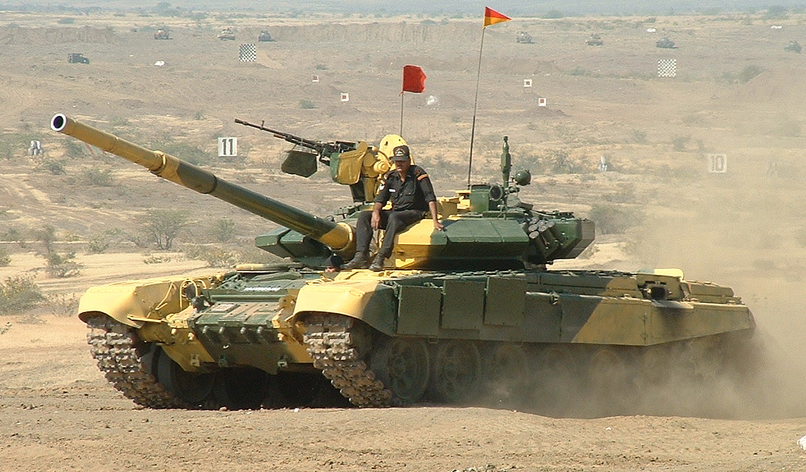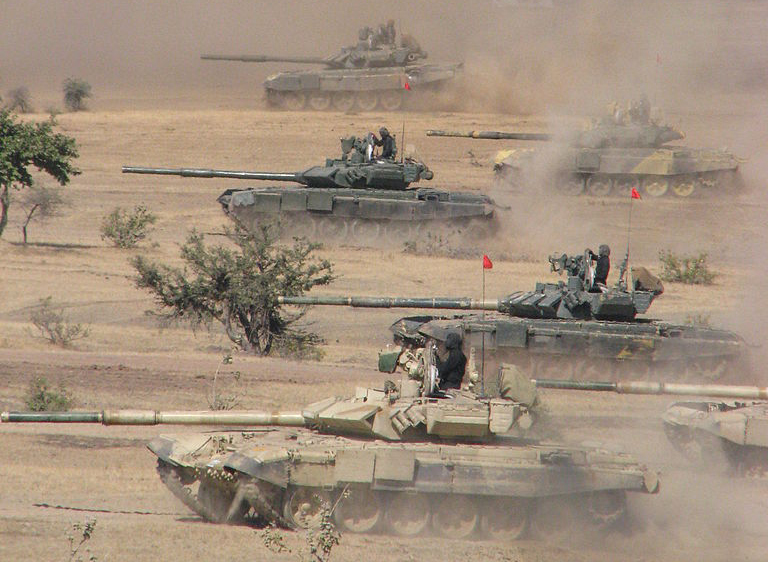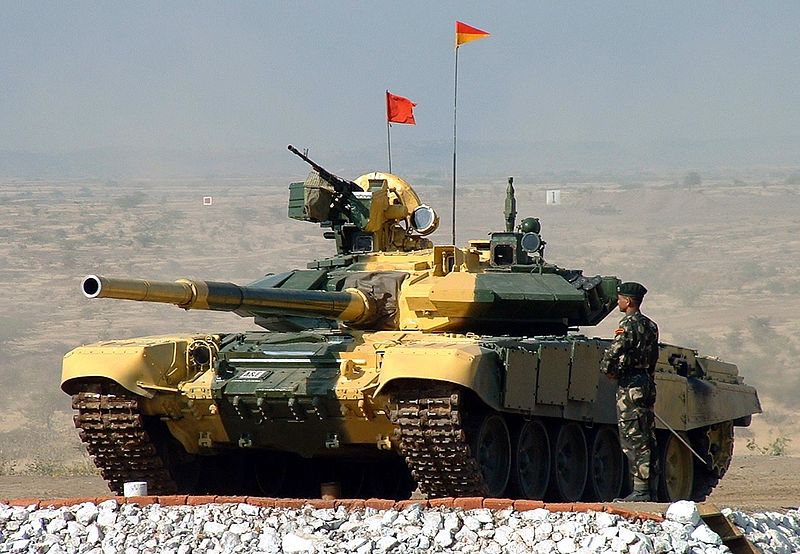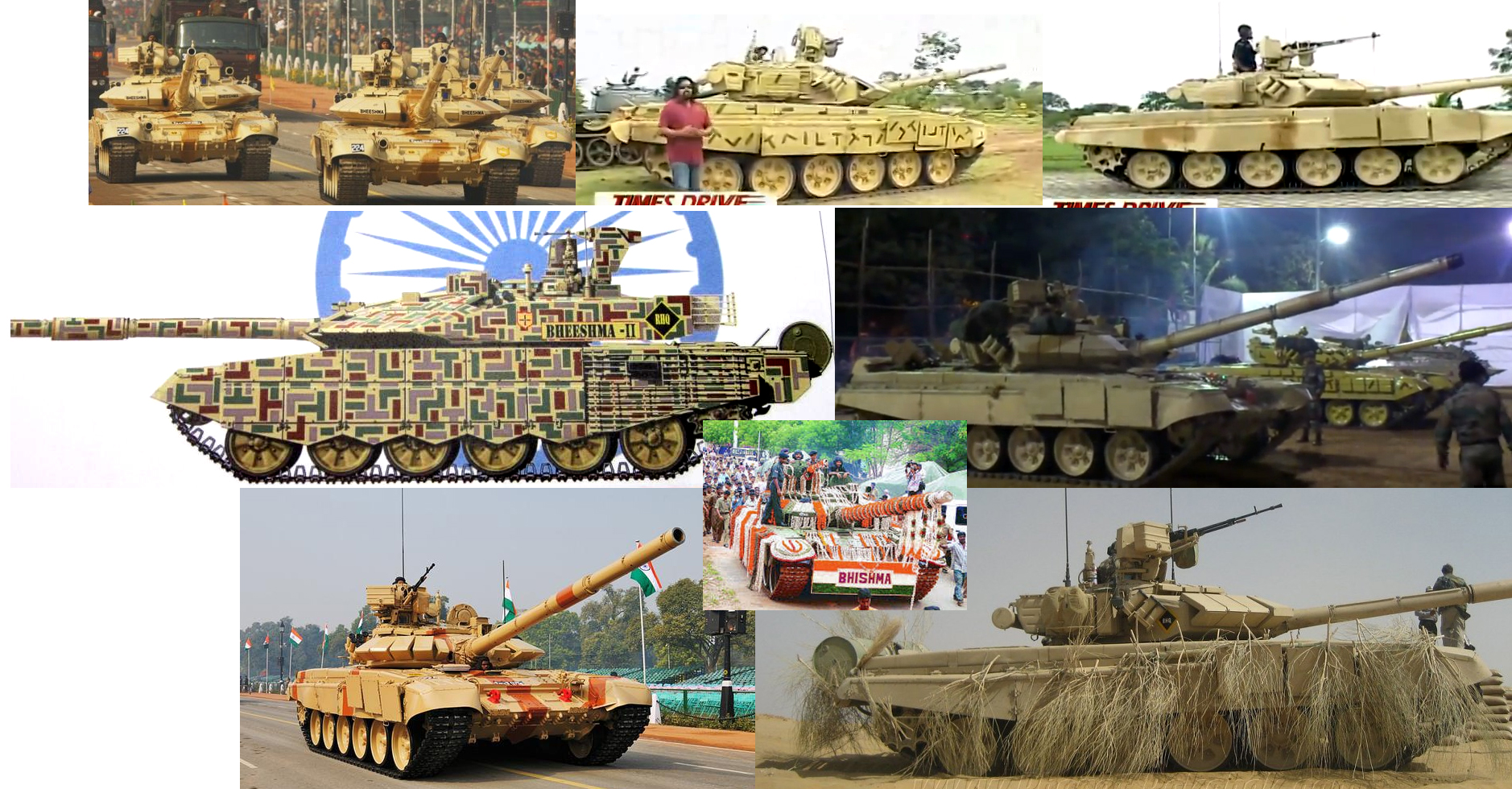The current top Indian tank
Unlike Russia, India was perhaps not ready for a "two tanks policy" back in the 1990s. But since the development delays of the proper Indian main battle tank, the Arjun, had rolled far beyond schedule, the local fleet of imported T-72M Ajeya was not sufficient enough as more modern tanks were needed. The T-80U was also tested at that time. Defined as a stopgap at first, the Russian T-90 was comprehensively tested and eventually adopted, imported entire, then partially, and totally assembled locally, with a proper license production (and local modifications) at the end. This has led in the early 2000s to the local T-90S "Bhishma" or Bheeshma, from a famous invincible warrior in the Mahabharata. The Arjun was, shortly after entering service, compared to the T-90S Bhishma and older T-72M Ajeya to decide its future in 2010, at the Mahajan Ranges, near Bikaner in Rajasthan. Eventually both tanks were kept and the Ajeya was scheduled for replacement by the Bhishma.Development
In 2001 around 310 T-90S tanks were imported from Russia, out of which 120 were complete but 90 in semi-assemblies and 100 to be assembled completely at the local facility. The decision was motivated on the double ground that the Arjun project was way beyond schedule mostly because of hydrogas suspensions system issues, and because the similarities between the T-90 and the T-72M were such that maintenance and training could be reduced significantly (the unit price also was to be much lower).Given the new features of the tank, basically a mix between the T-72 and the T-80U, the T-90 fleet would not need significant upgrades for at least a decade, allowing the Arjun to came into numbers in the meantime. License for production was eventually obtained in 2004, and the first prototype left the Heavy Vehicles Factory at Avadi, Tamil Nadu on January 7, 2004. Until 2009, ten other followed. By November 2012, it was announced an order for 330 T-90S with local modifications (see later) that must be built until 2020. Later on in 2007 a further order for 347 T-90M to be assembled locally was obtained. Adding to the 700 already partly assembled locally this made for an estimated total of 1,047 T-90 and 1,377 total of S/M by 2020.
In 2012 it was announced India will also assemble locally the new T-90SM (Bhishma II) until 2020, making by far the biggest contingent for this tank worldwide at 2011 tanks. However delays occurred at Avadi due to the lack of technology transfers and claimed copyrights from Russia by 2008 so according to officials a "Full-scale indigenization has been held up in Avadi".
Design
The T-90S Bhishma was essentially identical to the Russian T-90. It was given a more powerful engine to cope with the new armour and equipments, a jamming system a laser warning receivers, while still relying on a powerful 2A46M 125 mm smoothbore main gun with a thermal sleeve and muzzle detector that can fire a whole range of ammunitions including HE, Frag, HEAT, APFSDS and ATGMs which were developed in India. The improved night sights allowed to detect and engage targets at 700m to 1100m in pitch black darkness, fog or sandstorms while on the move and the gun is fully stabilized.The armour protection level rests on the hardened steel hull of the T-72 with inserts of composites in the turret front, and a layer of ERA bricks (KONTAKT 5) explosive armour. Secondary armament comprises a roof-mounted 12.7 mm and coaxial 7.92 mm machine gun. Mobility is assured by two planetary gear boxes for the transmission and two final drives, plus a snorkel allowing 5m of immersion with a 20 min. preparation. The limited weight of the tank was 45 tons, compared to the Arjun's 75+, allowing this tank to be air-transportable and compatible with most main bridges in India. However The Indian T-90S didn't have the Shtora-1 countermeasure suite, and the locally-built model is equipped with sights from Thales (France) and the Kanchan composite armour developed locally.

Camouflaged T-90S Bhishma in exercises
The T-90M (2007)
In 2007 a $1.23 billion contract for 347 T-90M Bhishma to be assembled locally was secured, including a large R&D programme by HVF. Differences with the previous T-90S includes the Kanchan ERA, Israeli Kinetics Ltd’s environmental control system to cope with desert conditions and Swedish LEDS-150 APS. There is also a cooling system for the new THALES Catherine-FC gen-3 thermal imager (which apparently caused problems at the beginning, now solved) operating in the 8-12 micron bandwidth, and housed within the Peleng-built 1G-46 gunner's sight. The commander's panoramic sight which houses the Matis-STD thermal imager that operates in the 3-5 micron bandwidth, is shared with the Arjun.This includes also a local automatic gearbox, local electro-hydraulic turret-drive-cum stabilization system, and 2A46M-5 Rapira smoothbore main gun barrel fitted with a muzzle reference system, 9S517 missile guidance module for refleks ATGM, 1V528-1 ballistics computer, DVE-BS meteorological sensor, licensed Elbit/Tadiran digitised battlespace management, plus new radio communications suite and locally-designed gyrobased nav system RPZ-86M. The hull is also coated with an anti-radar paint.
A large modernization program for the T-90S is also ongoing since 2014 with DRDO (the makers of the Arjun). The goal is to provide local air-conditioning systems, but also the protection systems, navigation gear, thermal imaging sights and fire control systems up to the new local T-90M standard.
The T-90MS Tagil (2013)
The export-oriented Russian T-90MS was also studied with great care. In 2011, the new MS was first unveiled and showcased in 2012 with the relikt encased turret structure (Relikt ERA), enhanced Kalina FCS, data system, sensors, and RWS at defexpo. The gun is allegedly capable to take on low-flying helicopters. There is also a 1,130 hp V-92S2F engine and improved suspensions for a 10-15 mph gain.An order was discussed during the event by the Indian authorities for 345 MS, providing six elite armoured regiments to be stationed on the china border. The new MS integrates among other things a RWS and an independent commander's panoramic sight and gunner's sight for a true hunter-killer mode, rear-mounted ammunition reserve stowage bustle and its autoloader to get rid of the ancient carousel under the turret which had been much criticized as an inheritance of the T-72.
This also enable the new FSAPDS rounds containing long-rod kinetic energy penetrators for the Indian Army. There is also a battlespace management terminal plus a fibre-optic gyro-based land navigation system. The MS also came with a software-defined radio suite and a health-and-usage management for on-board systems diagnosis. Apparently these systems are to be Indian-built and sent to Uralvagonzavod for assembly, as well as the new local active protection suite or Israeli Iron First APS. However by 2013 the agreement apparently was still in discussions and still is in September 2015.
The T-90 in service
The T-90 already delivered were given to seven regiments of the XXI (Bhopal) and II (Ambala) Strike Corps. In total 20+ armored regiments are planned to be equipped with the Bhishmas of all types, gradually replacing the older T-55 and T-72Ms. The story of the Bhishma is far too early to conclude anything about its capabilities in action, other than comparative prospects with the Russian "Vladimir" version of the T-90 potentially in action (in Ukraine or Syria for example).License production is just getting started as it have to go until 2020 to reach the desired level of availability for the bulk of the Indian armoured division in an area which gets hotter each year. The Bhishma is cheaper, easier to manufacture and to maintain that the Arjun, which can only be given to elite units due to superior capabilities and price tag alone. A good intermediate could be found in the new T-90MS Bhishma II, provided discussions came to positive conclusions
Links
The Bhishma on tanknutdaveArjun vs Bhishma (article) Bhishma production projects for 2020 (article) Another topic on the matter (2013) on defenceindia.com
T-90M Bhishma specifications |
|
| Dimensions | 9.63oa x3.78 x2.22 m (31.7 x12.5 x7.3 ft) |
| Total weight, battle ready | 47 tons |
| Crew | 3 (cdr, driver, gunner) |
| Propulsion | 950 hp (736 kW) for V-92S2 12-cyl. diesel engine |
| Suspension | Torsion bars |
| Speed (road) | 60 km/h (37 mph) |
| Range | 550 km (340 mi) |
| Armament | 2A46M-5 125 mm sb, 42rds, 12.7mm Kord HMG, 7.62mm PKMT |
| Armor | Steel-composite-reactive blend, ERA Kanchan/Kontak 5 |
| Total production | Current |
Video
T-90S Bhishma unloaded from its trailer and parked for a public demonstration in Mumbai. Notice the differences of liveries with the T-72B behind.
Gallery
 Several T-90 Bhishma in exercises in the Thar Desert, Rajasthan. Notice the variations of liveries, from beige to dark olive green and two different turret armour arrays.
Several T-90 Bhishma in exercises in the Thar Desert, Rajasthan. Notice the variations of liveries, from beige to dark olive green and two different turret armour arrays.

Camouflaged T90S Bhishma in presentation.

Various references from the Web
 T-90S Bhishma in beige livery partially camouflaged, 2000s
T-90S Bhishma in beige livery partially camouflaged, 2000s
T-90 Bhishma in a regular straight lines pattern camouflage

T-90 Bhishma with a Blended livery

T-90M with "Vermicels" style livery

The T-90MS Bhishma II as officially presented by as the "Tagil Tropic" with a pixel camouflage. Discussions for a planned delivery of 345 MS was still ongoing as of September 2015.

Modern Tanks
Modern MBTs posters

Denel Bagder (2018)

Type 16 MCV (2016)

Gepard 1A2 last rounds 2011

SANDF

Russian AFVs

Main Battle Tanks
